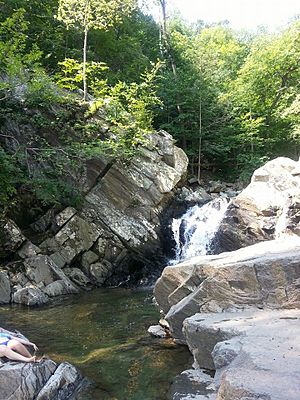Scott's Run Nature Preserve facts for kids
Quick facts for kids Scott's Run Nature Preserve |
|
|---|---|

Waterfall near the end of Scott's Run in the northwest corner of the park
|
|
| Lua error in Module:Location_map at line 420: attempt to index field 'wikibase' (a nil value). | |
| Type | Nature preserve |
| Location | Fairfax County, Virginia |
| Nearest city | McLean |
| Area | 336 acres (136 ha) |
| Created | 1970 |
| Operated by | Fairfax County Park Authority |
| Open | One-half hour before sunrise to one-half hour after sunset |
| Status | Open |
Scott's Run Nature Preserve is a special nature preserve located in Fairfax County, Virginia, United States. You can find it in McLean. The preserve is surrounded by Virginia State Route 193 to the south and Interstate 495 to the east. The Potomac River forms its northern border.
This beautiful area covers about 336 acres (136 hectares) of woodland. A stream called Scott's Run flows through the western part of the preserve. This stream starts in nearby Tysons Corner. It then joins the Potomac River on the northwest side of the preserve. Scott's Run Nature Preserve is famous for its eastern hemlock trees. These trees are quite rare in this part of Virginia. It's a popular spot for people who enjoy being outdoors and going for hikes. The Fairfax County Park Authority manages and takes care of the preserve.
History of Scott's Run Preserve
Before it became a nature preserve, this land belonged to a man named Edward B. Burling. He was one of the people who started the Covington & Burling law firm. In the 1920s, Mr. Burling bought the land. He paid about $200 for each acre. He also built a small cabin on the north side of the property. He used this peaceful place to relax and sometimes hold informal business meetings.
After Mr. Burling passed away in October 1966, his family decided to sell the land. They wanted to avoid the taxes that came with owning such a large property. A company called Miller & Smith Associates (MSA) bought the land. They planned to build 309 fancy homes there. This area was known as the "Burling Tract." Their plan also included leaving about half of the land untouched.
However, a neighbor named Elizabeth Miles Cooke noticed the plans for development. She lived right next to the Burling Tract. She decided to help organize people who were against the building project. There was a long discussion involving citizens, the Virginia Governor, and even some U.S. senators. Developers and local groups also took part in the debate.
Finally, on July 14, 1970, voters made a big decision. They chose to raise their taxes to help buy the land. This vote would provide $1.5 million. The Department of the Interior added another $1.5 million. State and local governments gave $0.6 million. On September 5, 1970, Fairfax County officially bought the land for $3.6 million. This is how Scott's Run Nature Preserve was created for everyone to enjoy.


